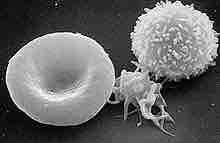Blood is a circulating tissue composed of fluid, plasma, and cells. The cellular components of blood are erythrocytes (red blood cells, or RBCs), leukocytes (white blood cells, or WBCs), and thrombocytes (platelets). By volume, the RBCs constitute about 45% of whole blood, the plasma about 54.3%, and white blood cells about 0.7%. Platelets make up less than 1%. Although it consists of cells suspended in fluid, blood is still considered a tissue as it is technically a type of extracellular matrix.
Blood enables transport of cells and molecules between parts of the body. Oxygen, carbon dioxide, and glucose are among the most vital molecules transported in blood. Blood cells are essential for normal metabolic and immune system function.

Composition of Blood
Two tubes of EDTA-anticoagulated blood. Left tube: after standing, the RBCs have settled at the bottom of the tube.
Erythrocytes (RBCs)
Erythrocytes are discs measuring about seven to eight micrometers in diameter. RBCs contain hemoglobin molecules which bind to oxygen so it can be transported to tissues. Mature RBCs lack a nucleus and organelles and have no nuclear DNA. RBCs, endothelial vessel cells, and other blood cells are also marked by glycoproteins that define the different blood types. The ratio of RBCs to blood plasma is referred to as the hematocrit, and is normally about 45%. The combined surface area of all red blood cells of the human body would be roughly 2,000 times greater than the body's exterior surface.

Components of Blood
From left to right, a diagram of an erythrocyte, thrombocyte, and leukocyte.
Leukocytes (WBCs)
Leukocytes are usually larger in size (10-14 micrometers in diameter) than red blood cells. They lack hemoglobin but contain organelles, a nucleus, and nuclear DNA. WBCs are the main functional component of the body's immune system. They destroy and remove old or aberrant cells and cellular debris, as well as attack infectious agents (pathogens) and foreign substances. There are several different types of white blood cells: basophils, eosinophils, neutrophils, monocytes, natural killer cells, B- and T-cell lymphocytes, macrophages, and dendritic cells, all of which perform distinct functions.
Thrombocytes (Platelets)
Thrombocytes measure between one to two micrometers in diameter. These membrane-bound cell fragments lack nuclei and are responsible for blood clotting (coagulation). They result from fragmentation of large cells called megakaryocytes, which are derived from stem cells in the bone marrow. Platelets are produced at a rate of 200 billion per day, a process regulated by the hormone thrombopoietin. Platelets contain mitochondrial DNA, but not nuclear DNA.
The sticky surface of platelets allows them to accumulate at the site of broken blood vessels to form a clot, due in part to the release of clotting factors that occurs during endothelial injury to blood vessels. This process is called hemostatis. Platelets secrete factors that increase local platelet aggregation (e.g., thromboxane A), enhance vasoconstriction (e.g., serotonin), and promote blood coagulation (e.g., thromboplastin, fibrinogen). Platelets are critically important for wound healing, which can only occur once the clot forms and bleeding ceases completely.